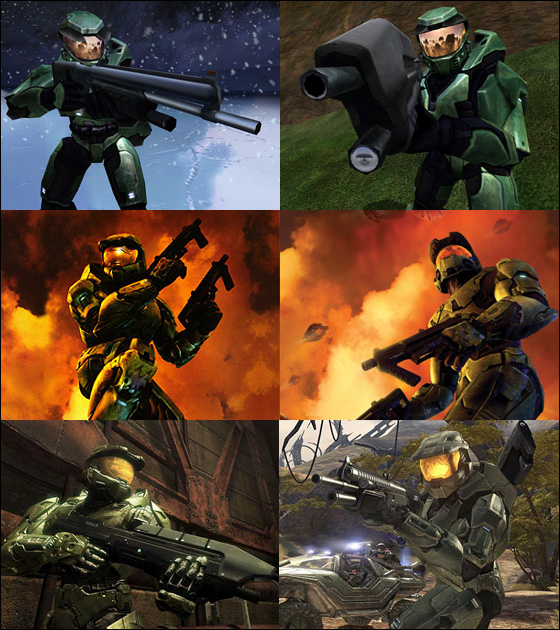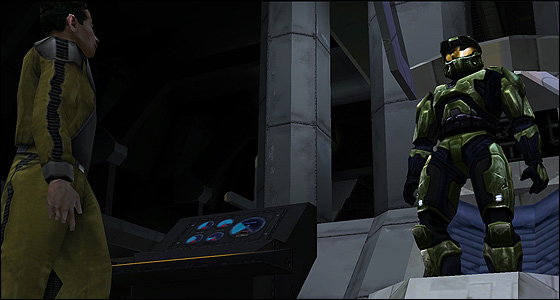Halo – The Issues
September 14th, 2009

In my previous Halo-themed article I mentioned that I’d write about the franchise’s iconic science fiction theme. Honestly? I gave it a red-hot go, but unfortunately the final write-up wasn’t very flattering, so I’ve decided to skip that part and move onto the other proposed article — flaws and weaknesses. Maybe I’ll reuse the canned material for my next post.
A good portion of my criticisms leveled towards the franchise are superbly written up in Daniel Weissenberger’s review of Halo 3 for GameCritics.com. You should take a read once you’ve read this, of course.
It’d be safe to say that few video game franchise reel the haters quite like Halo. Personally, I can swing either way. My assertions made on Halo‘s influence as discussed in my Halo – Building the New Standard post are all objectively true; the series has simply done a lot for the genre. The disdain that many hold towards the franchise is also an equally legitimate argument too. Let’s delve into the other side a little;
Level Design, Pasting and Momentum
The highs are so high and the lows so low. That’s probably a good description of the level design throughout Halo and Halo 2. Halo is a very iterative series, with the same homogenized strengths and weaknesses in design shaping the first game, effectively reoccurring to carve away at the two sequels. Halo in particular is top heavy, with the best levels stuffed into the front and the drawn-out, weaker levels in the back. It’s a good representative sample of the issues at play, so let’s take a poke.
After a weary, corridor-shooter-esque introduction to a fairly generic science fiction premise in Pillar of Autumn, the benchmark is quickly set high with the excellent (and again, self-titled) Halo. Halo provides a refreshing entry point for the series to strut it’s large playing fields and open-ended environment, while introducing the franchise favourite warthog. It’s a very iconic level and for good reason. The momentum slows for Truth and Reconciliation which is a quieter romp. Truth and Reconciliation is the intentional lull period leading into The Silent Cartographer which builds the pace once again. In a similar vein to Halo, The Silent Cartographer is both open-ended and engaging through the respective two-way, circular design of the island and the generous serving of supporting marines and vehicles.
The next level, Assault on the Control Room, is where the game begins to taper off. From the surface level, there appears to be little wrong with Assault on the Control Room. The player moves from a range of indoor and outdoor environments, travels both on foot and by vehicles, and takes out Covenant foes which man turrets, vehicles and are generally smart with their offensive tactics. The problem is two-fold. Firstly, the maze of samey environments as best described by Jeremy Parish:
“It’s the first mission set almost entirely within Forerunner structures, which tend to be very homogeneous. Clean, geometric layouts, antiseptic colors, not much in the way of visual references — if not for blood decals from your diligent Covenant-killing activities, you’d often have no sense of where you’d already been. Oh, yeah, and the outdoor areas are all snow, so they’re as stark and barren as the interiors.” [1]
The second – a catalyst to the first – is the drawn-out, marathon length of several of these later missions*. The charade of bland, uninteresting environments simply drags on for far too long, leaving you feeling dissatisfied. Further, this is exacerbated by the fact that by this stage, the initial high has worn off and you’re left to ponder the game’s worth.
*That was not a bad pun
(One could say that by keeping the level designs consistently the same, Halo attempts to shift the maximize the focus on utilizing the repertoire of techniques, and concentrating on enemy spawn patterns and other variables of combat. True, but that doesn’t prevent the levels from being dull, repetitive and uninteresting.)
The rest of the game sadly conforms to these issues, and considering that such proportion of levels constitutes the majority of the game, it’s questionable how Halo ever received such acclaim. The highs are so high and the lows so low, indeed.
343 Guilty Spark begins in a dank jungle before entering – and almost never leaving – the alien interiors. 343 Guilty Spark also introduces the Flood (a new type of alien life form; zombies), an inelegant gimmick to offset your waning enthusiasm. It’s unfortunate then that the Flood are used to complete and utter excess that by the time you’ve completed 343 Guilty Spark, The Library, Two Betrayals and Keyes you’ve almost been knocked unconscious (or dead) by the over zealous pasting of level design.
As you can probably tell, the three other aforementioned levels are all pretty terrible, The Library being notorious for its over copious use of copy and paste, and Two Betrayals and Keyes for not even trying. Two Betrayals being a reversed Assault on the Control Room in a night time setting and Keyes as a back tread through the later, less exciting half of The Truth and Reconciliation. They’re nothing but filler.
The Maw is another retread, this time trough the very first level (Pillar of Autumn). The catch is that it actually feels significantly overhauled after crashing on Earth and resting on the side of a cliff…I presume. The conclusion ends with the warthog sequence which – aside from a few pillars in the middle of the runway – is a great way to conclude the game.
If we tally up the levels, only 40% suffice the exorbitant amount of pre-release hype, Is this reasonable given Halo‘s stature? Probably not.
Shallow, Domineering and Unsophisticated
If you’re a hater of the Halo franchise, the above 800 words make for half a rational argument against the series. The other, primary point of contention is usually what receives the most attention though. Halo has an unmistakably macho vibe about it which can be negatively summarised by the adjectives in the heading (shallow, domineering and unsophisticated). For many, I suspect, the abhorrent machoism/men of war thematic is probably a huge turn off. I know that for a girly man like myself it’s certainly a little intimidating, if not, entirely to my tastes at times.
Unfortunately, despite this equally legitimate complaint, this side of the argument is often poorly articulated by players who hold the series in contempt. I don’t blame them though as it’s extremely multi-faceted and deeply embedded in the individual, subjective response to the game. Here are some of the compounding factors:
Power Fantasy in Space
If you’ve played the Halo games you know one thing: Master Chief is the undisputed bomb. Sure, he works alongside the other marines, but let’s face it, they’re simply cannon fodder to make The Man look cooler. The pre-release promo pics of the chief are highly indicative of the masculine angle.

The scaffolding used to aid in creating this (well crafted) power fantasy is obvious as much as it is numerous. Narrative-wise, you’re role as humanity’s last point of defence is constantly made apparent both during cut scenes and gameplay. The main story, as presented through the cut scenes, is a series of slick stunts to make Master chief look valiant for the camera. Furthermore, the voice acting conform to the typical bad-boy tropes. Actually, I found some of his dialogue, particularly when he swears to be of try hard caliber. The music, in both playable and non-playable sequences suitably elevates the mood, giving credence to the fantasy. During gameplay, your UNSC cronies constantly make you the centre of attention with their wrath of compliments and frat boy cheering and carry-ons.
In terms of mechanics, the Chief is practically invincible relative to his fellow, meat shield marines. They drop dead like flies whilst the Chief can not only take more damage but also duck out to quickly regen his life bar. Of course, he’s robotic and they’re not – but that’s the point, you’re the centre of attention.
Frat Boy Mentality
This problem is partly inherent to Halo’s approach to first person conventions. As previously discussed, Halo’s large, natural environment, squad system and dense number of enemy AI create a believable war-like playground. Through this model itself, feelings attributed to war can be inferred from the game. On the other end of the scale, the UNSC marines very clearly treat the war as a form of sport, a ritual killing of alien scum. This comes through via the chatter, remarks and slurs shed out on the battlefield. Less noticeable, albeit, no less important is that often some soldiers will continue shooting aliens even after they’re dead. I usually don’t prefer to hang with the posse too much, but I did catch sight of this a few times with relevant shoot-him-while-he’s-dead dialogue included.
Monolithic Graphics
The Halo games are visually beautiful because of their ginormous scale in rendering large masses of environment which dominate the playing space. The large scope reduces the amount of texture detail which can be rendered by the hardware. This results in large chunks of environment painted with uniform textures, matching the monolithic size of the land through similar properties of design. The graphics are in essence conforming to the aspirations of the game; for Halo to have a broad scope, textures need to be smartly applied in this manner. Visual presentation to match the form.

That isn’t to assert that the game look bad either, rather the scope of the game heavily impacts the visual style guide, for which some players have issues with. I personally think the technical and artistic qualities are great (although, yes, repetitive alien interiors do get repetitive, that’s another matter though), and that players might be overlooking the technical beauty for artistic design – hence unfairly comparing Halo to say Metroid Prime. The difference is that Metroid Prime is a tight series of hallways with beautifully organic, heavily detailed visual design and Halo is a couple of interconnected, large expanses with pasted slabs of textures. You don’t ever see Samus on the back of a giant scarab trolling through a city now do you?
Only Combat
Aside from a few press-button-to-open-door puzzles (if you can call them that!), Halo is strictly a combat-only game. That combat may have many faces to it, but at the end of the day all rooms connect to skirmishes, which connect to more rooms with skirmishes and so on, ad nauseam. Halo rarely deviates from thick-headed combat which for many substantiates their reasoning as to why the game is shallow.
As with the monolithic visual design, your opinions may vary. The combat is slick, so if that’s your biz then Halo delivers. Expecting heavy amount of exploration runs contrary to the system. Halo does one thing (the pew-pews!) and shines it to perfection, does that necessarily make it “dumb” and unsophisticated….perhaps, but it’s the very nature of the game.
NB: Despite the teensy weensy paragraph, the above point is usually the crux of people’s argument. Not really an argument really, is it? Just a preference. The initial two points on the other hand are more so objectively true.
Additional Readings
Revisiting Halo 2 Part #3 – Retronauts
Revisiting Halo 2 Part #2 – Retronauts
Revisiting Halo 2 Part #1 – Retronauts



 Game Design Companion: A Critical Analysis of Wario Land 4 - $7.99
Game Design Companion: A Critical Analysis of Wario Land 4 - $7.99 Level Design: Processes and Experiences
Level Design: Processes and Experiences Speed Boost: The Hidden Secrets Behind Arcade Racing Design - $5.99
Speed Boost: The Hidden Secrets Behind Arcade Racing Design - $5.99 Adventures in Games Analysis: Volume I - $5.99
Adventures in Games Analysis: Volume I - $5.99







